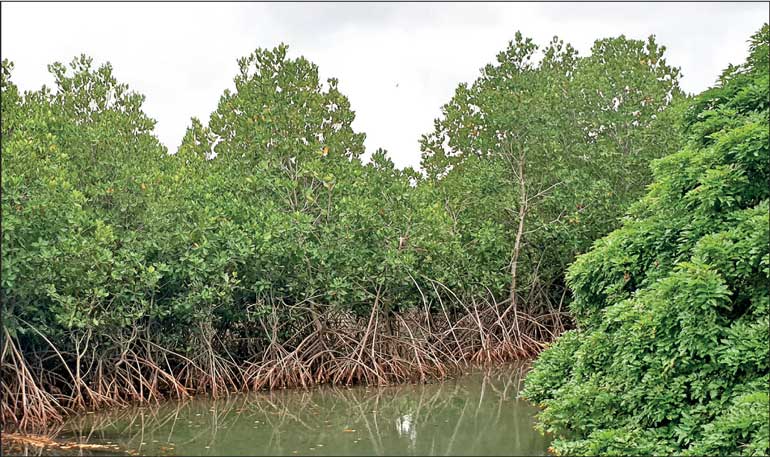Monday Dec 15, 2025
Monday Dec 15, 2025
Saturday, 23 March 2024 00:10 - - {{hitsCtrl.values.hits}}

Mangrove ecosystems hold significant potential to advance climate change
mitigation and adaptation at the same time
 The importance of mangrove forests and their unique characteristics as liminal ecosystems between land and sea has been firmly established through decades of research and field work. Hectare by hectare, mangroves store more carbon than any other forest ecosystem and provide habitats for an astonishing range of terrestrial and marine biodiversity. Furthermore, they also offer protection, livelihood opportunities, and a broad range of ecosystem services to communities along the coastlines of tropical countries, including
The importance of mangrove forests and their unique characteristics as liminal ecosystems between land and sea has been firmly established through decades of research and field work. Hectare by hectare, mangroves store more carbon than any other forest ecosystem and provide habitats for an astonishing range of terrestrial and marine biodiversity. Furthermore, they also offer protection, livelihood opportunities, and a broad range of ecosystem services to communities along the coastlines of tropical countries, including
Sri Lanka.
Due to these factors, mangroves also hold significant potential to advance climate change mitigation and adaptation not only at the national level, but by contributing to regional and global efforts as well. At the sixth meeting of the United Nations Environmental Assembly (UNEA-6) in February/March 2024 in Kenya, mangrove regeneration in Sri Lanka was recognised as one of seven new World Restoration Flagships, which honours “the best examples of large-scale and long-term ecosystem restoration” across the world. Mangrove ecosystems in the country can play a key role for contributing towards climate commitments, biodiversity targets, and a blue and sustainable economy.
Mangrove conservation and the UNFCCC process
The 28th meeting of the Conference of the Parties (COP28) to the United Nations Framework Convention on Climate Change (UNFCCC) in late 2023 cast a spotlight on several key issues related to climate change and global climate action. This includes ambitious emission reduction and a clean energy transition; the urgency of scaling up climate finance; and the need for addressing climate-induced loss and damage.
In addition, COP28 also highlighted the critical role of “protecting, conserving and restoring […] water-related ecosystems,” preserving and restoring “oceans and coastal ecosystems,” and “ensuring the integrity of all ecosystems.” As water-based coastal ecosystems, mangroves offer an especially high cost-benefit ratio, as was put forward by the Intergovernmental Panel on Climate Change as well, which states that “natural ecosystems such as […] mangroves have considerable value in acting as carbon sinks as well as providing other ecosystem services” and can “help people in a wide range of other ways, including through providing food, materials, and providing opportunities for recreation.” (IPCC AR6 WGII)
Connecting mangrove conservation on the ground with these high-level goals and national climate commitments can pose a challenge. One of the key negotiation outcomes of COP28 is the UAE Framework for Global Climate Resilience, which outlines the way towards fully operationalising the Global Goal on Adaptation (GGA) established under the Paris Agreement paragraph 7 (1). Nature and natural ecosystems feature prominently in the framework, which aims, inter alia, to guide and strengthen efforts towards “the preservation and regeneration of nature, for current and future generations.”
The GGA framework also includes seven thematic targets as well as four process-oriented ones, with target (d) focusing on “reducing climate impacts on ecosystems and biodiversity, and accelerating the use of ecosystem-based adaptation and nature-based solutions, including through their management, enhancement, restoration and conservation and the protection of terrestrial, inland water, mountain, marine and coastal ecosystems.”
Mangroves can play a crucial role in contributing to this target and strengthening the adaptation of coastal communities and regions. During 2024-2025, Parties to the UNFCCC and other stakeholders will work towards developing relevant indicators for the targets of the framework through the UAE-Belém work program, including target (d) and its focus on natural ecosystems and biodiversity. Contributing to this indicator development with national data, good practices, and lessons learned from countries such as Sri Lanka could help to ensure that these indicators are evidence-based and compatible with existing planning, implementation, monitoring, and reporting systems without creating additional burdens or obligations.
Advancing global and regional processes
The UNFCCC and its Paris Agreement are the main forum for global climate action, but mangroves have the potential to feed into other international processes as well. At the global level, this includes, for example, the Sustainable Development Goals, where mangroves could contribute to goals such as SDG 2, SDG 6, SDG 8, SDG 12, SDG 13, SDG 14, SDG 15; the Kunming-Montreal Global Biodiversity Framework, which has a range of relevant targets on biodiversity protection; or the Mangrove Breakthrough, a global vision to restore and protect 15 million hectares of mangroves and halt mangrove destruction by 2030, which was launched at COP27 and further strengthened at COP28.
At the regional level, Sri Lanka is currently Chair of the Indian Ocean Rim Association (IORA), which has thematic focus areas on blue economy, fisheries management, and disaster risk reduction, among others; the country has also been chairing the Action Group on Mangrove Ecosystems and Livelihoods under the Commonwealth Blue Charter since 2019.
Pathways towards coastal adaptation and resilience
The potential of mangroves has been recognised in key plans and policies of Sri Lanka, such as the country’s Nationally Determined Contributions (which include several mangrove-related commitments), its National Adaptation Plan (which commits to participatory management and conservation of mangroves), or the Climate Prosperity Plan (which looks at mangrove-based carbon credits and employment generation).
Mangroves can contribute to these national plans and commitments as well as to international processes and global goals related to climate change, biodiversity conservation, and sustainable development. However, successful mangrove conservation, restoration, and assisted natural growth hinge on a sound scientific basis as well as the sustained involvement of key local and national stakeholders, including communities, government authorities, and the private sector. The true challenge in harnessing the power of mangroves for climate action and blue economic growth lies not in planting but in setting up inclusive and participatory frameworks that facilitate the long-term survival of mangroves while benefitting local communities at the same time.
(The writer works as Director: Research and Knowledge Management at SLYCAN Trust, a non-profit think tank based in Sri Lanka. His work focuses on climate change, adaptation, resilience, ecosystem conservation, just transition, human mobility, and a range of related issues. He holds a Master’s degree in Education from the University of Cologne, Germany and is a regular contributor to several international
and local media outlets.)